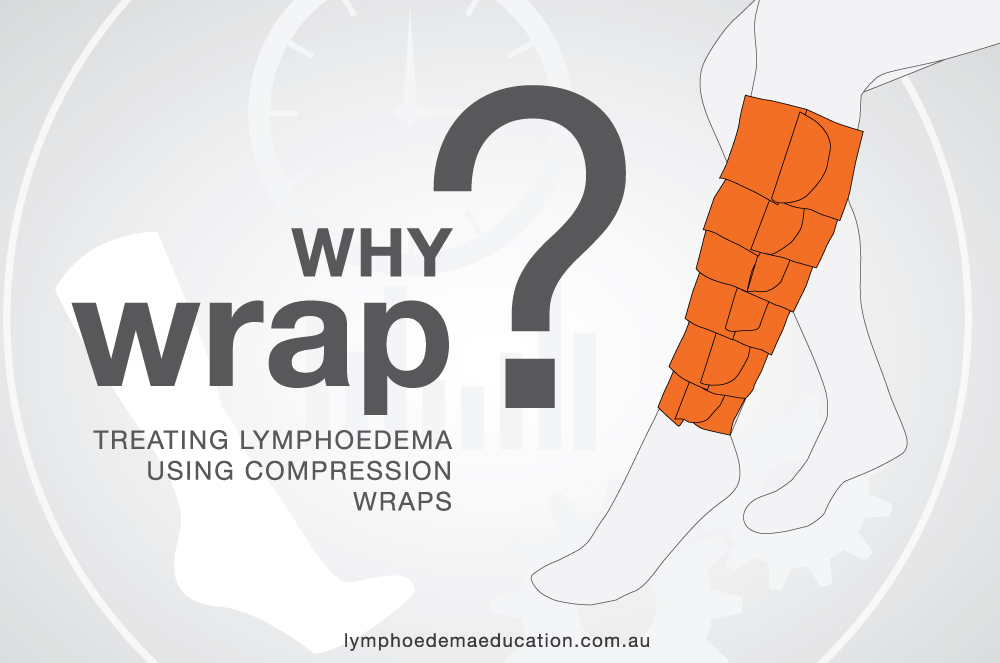Why wrap?
Treating Lymphoedema using Compression Wraps

Page updated August 2021
Compression is an essential component of chronic oedema management and over the years various options have emerged that have allowed the practitioner to tailor management to best suit their client. One such option is the compression wrap. This device has now become an essential part of the chronic oedema management tool kit.
These devices have become much more popular in the last 5 to 10 years but the first wraps, for lymphoedema, were available much earlier. Circaid and the Reid sleeve were some of the first wrap devices on the US market in the mid 1990’s. They weren’t as popular then and were seen to be bulky and the question of what compression they applied was questioned. They were first released into the UK in 2007 and Australia in 2010. Over time new generations of these products have been developed. There still remains a lack of scientific research into their use but there have been a growing number of publications. This article will explore what, when, why, how. To read about the research evidence click here
What is a wrap?
These devices are made of short stretch material which has the ability to achieve a high working pressure when the person is moving and a low resting pressure. It is designed to replicate short stretch bandaging. It is generally made up of a flexible spine with multiple overlapping bands that are secured via Velcro. Most wraps are made up of non-woven laminated fabrics except for the Easywrap. The Easywrap, for the lower limb, has the ability to lock out like a short stretch bandage due to specifically designed woven fabric which also ensures it bands do not kink or neck. The Circaid has a built-in-tension system that uses a guide card that the manufacturers claim supports a repeatable level of tension.
Wraps are available in sections. For the upper limb this consists of a hand piece and an arm piece. For the leg there is a foot, calf, knee and thigh piece. This allows for ease of application and combination of sizes to get the best fit. There are also a light compression and strong compression for the lower limb.
Indications
Published clinical papers have suggested the following indications for wraps:
- Intolerance to bandaging.
- Intolerance for garments.
- Where there is difficulty donning and doffing compression garments.
- Distorted limb shape.
- Post – bandage rebound oedema.
- Back problems (however you still need to lean forward to apply the calf and foot piece).
- Non- compliance.
- Neuropathy.
- Palliative care.
- Obesity related oedema.
- Skin sensitivity or fragile skin.
- Large volume reduction as it can be readjusted easily by the client.
- If a carer needs to apply compression this may be a safer and easier option.
Advantages
Below is a list of possible advantages. It isn’t an exhaustive list but highlights the many reasons for the practitioner to have wraps as part of their management repertoire.
- Within the literature, so far, there are no reports of any adverse effects of using wraps.
- The client can take control in both the initial treatment phase as well as the ongoing maintenance phase. This may lead to improved concordance.
- Easily adjusted as the limb reduces.
- Stiffness remains longer than bandages as the wrap can be adjusted throughout the day and therefore maintains a consistent level of compression during the day.
- Cost effective. It may reduce clinical intervention.
- Easy and quick for the client or care giver. Clients and caregivers can quickly learn how to apply the wrap and each brand has application videos.
- They can be used in conjunction with compression garments. An example of this is the client may be able to put a below knee garment on and where a wrap for the thigh. This can be an advantage for some one that has continence issues as they can undo the top section of their wrap.
- They can be used in conjunction with bandages. It may be cost and clinically effective, due to body shape or volume to be reduced, to bandage below the knee and use a wrap for the thigh section.
Contraindications
Contraindications and precautions are the same for applying any compression therapy. These include:
- Infection and acute inflammatory episode
- Severe peripheral arteriosclerotic disease
- Decompensated heart failure
- Deep venous thrombosis
Proceed with caution with:
- Diabetes
- Peripheral neuropathy
Some clients may find the foot section difficult to apply if they have poor mobility as they need to be able to reach their feet.
How
There are a number of resources provided by the various companies including measuring and application videos.
FarrowWrap
This wrap is supplied by BSN medical Australia Pty Ltd
Lower limb knee application
Lower limb thigh application
Measuring video
Lower limb foot application
Upper limb application
Lower limb leg application
Easywrap
This wrap is provided by Haddenham Healthcare.
Measuring resources at http://www.easywrap.info/sizing.html
Application resources at http://www.easywrap.info/application.html
Application video
Measuring for lower limb
Measuring for upper limb
ReadyWrap
This wrap is manufactured by L & R, distributed by Medical Accessories & Cosmac Surgical.
Product information
Measuring video
Application video
TributeWrap
This wrap is manufactured by L & R, distributed by Medical Accessories & Cosmac Surgical.
Product information
Below knee
Armsleeve and glove
Circaid Juxtafit
This wrap is provided by Medi Australia
Lower limb application
Upper limb application
You can further expand your knowledge and skills in this area by completing lymphoedema training. Lymphoedema Education Solutions has a course that will meet your needs ranging from:
- Level 1 and Level 2 lymphoedema courses.
- Chronic oedema lower limb course.
- Design a course to meet your needs.



